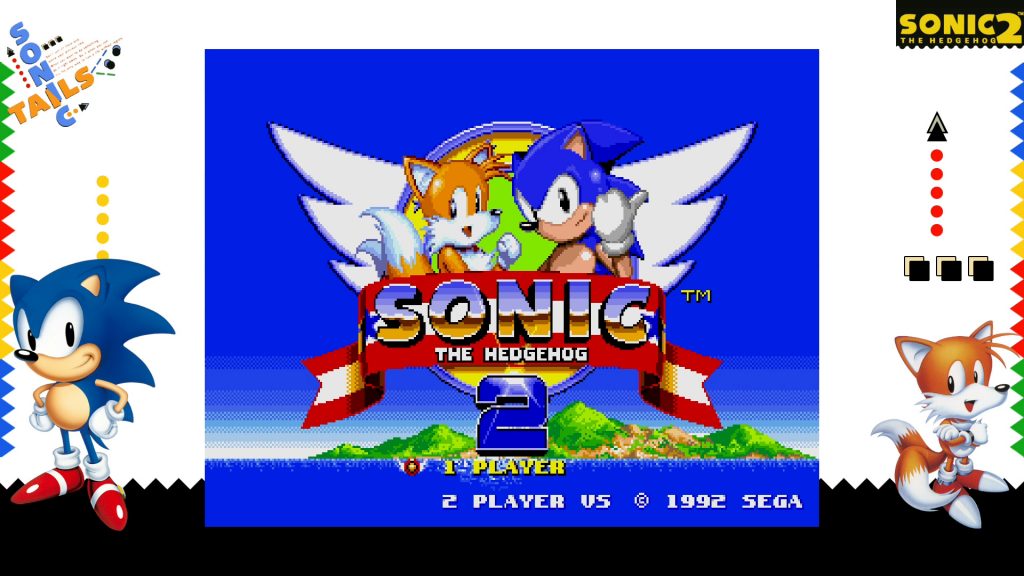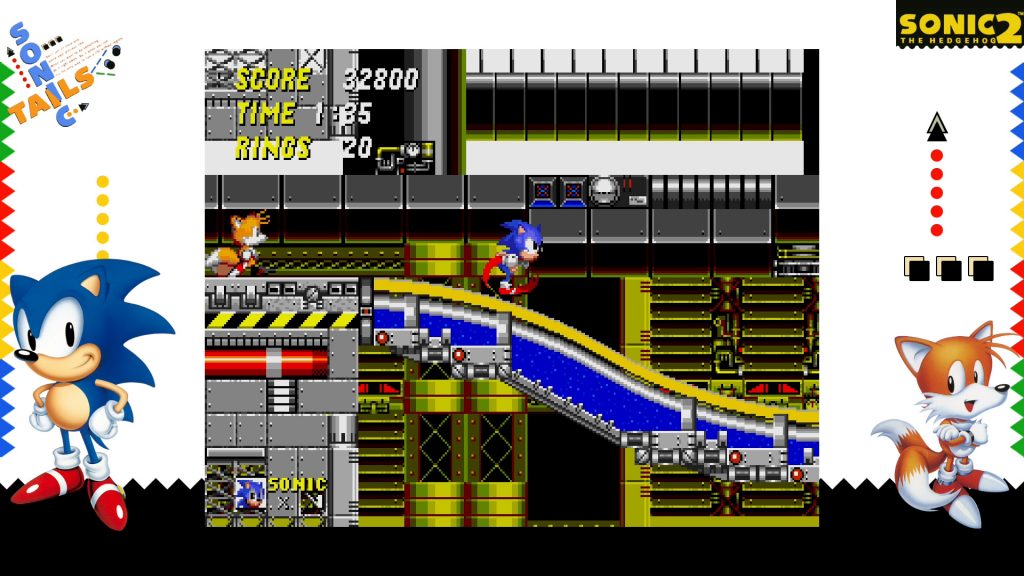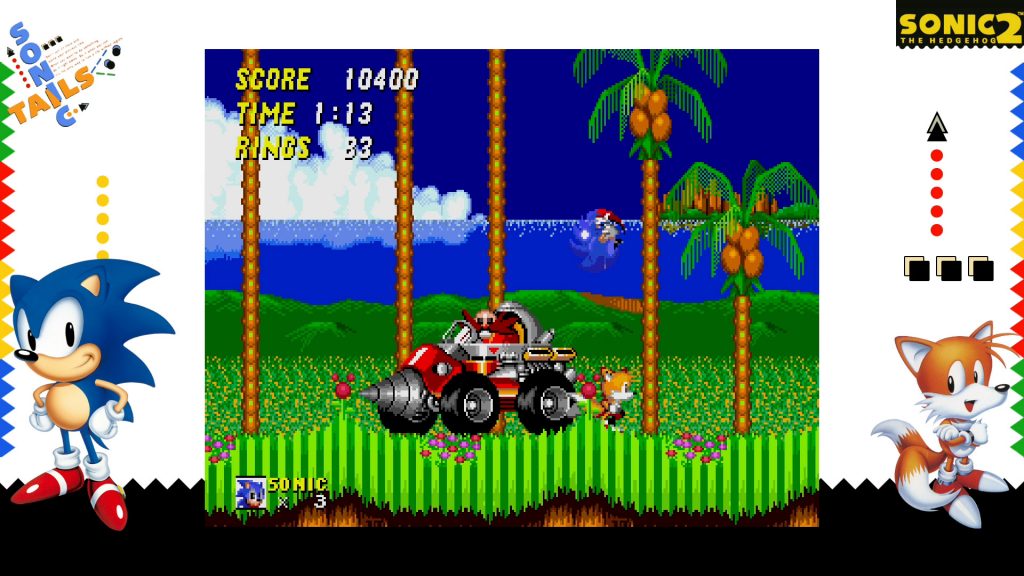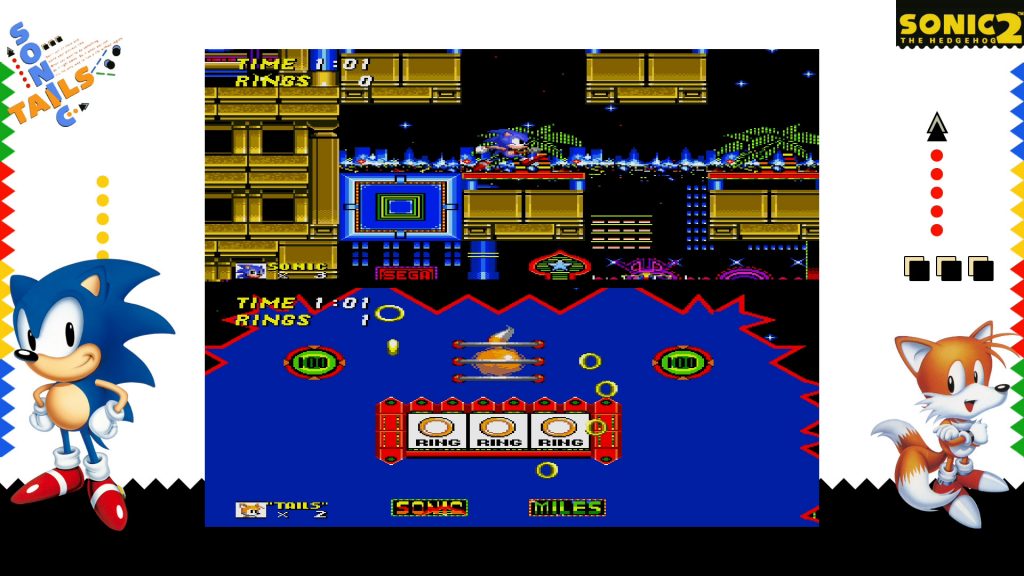
Yes, you read right… this is a review of Sonic the Hedgehog 2. Sega Ages: Sonic the Hedgehog 2, to be more precise. For the uninitiated, a little history…
Back in 1991, when Sony made stereos and Microsoft made operating systems for PCs which would make your grandma’s egg timer look fancy and cost the same as a small car, a fledgeling Sega was looking to challenge Nintendo in the console wars. Sega had struggled with the Master System, their attempt to replicate the success of the NES. Part of the reason for this was that Nintendo had an ace in the hole; (Super) Mario; a man whose chief personality traits to this day are having a moustache, wearing a hat and eating suspicious fungal things which fall out of the blocks he punches.
Sega had nothing. Or, to be more accurate, they had Alex Kidd, the video game character equivalent of nothing. It was clear that they were not going to ignite the imagination of the masses with a rock paper scissors-obsessed monkey-human hybrid wearing an 80s tracksuit. Sega needed a character to rival Mario if the 3-year-old Mega Drive/Genesis was to be a success.

Then, like a (blue) bolt from the blue, came Sonic the Hedgehog, star of… er, Sonic the Hedgehog. Sonic was everything Mario wasn’t; fast, cool, anti-fungal and full of 90s ‘tude. He didn’t waste his time forcing himself into pipes and abusing turtles*. Sonic was a runaway success, and suddenly he was all over lunch boxes, backpacks and pencil cases. It wasn’t long before Sega became a contender and Nintendo and Mario began filling their collective dungarees.
Sega’s approach to the sequel to their smash hit was to do everything bigger and better. Sonic was able to reach faster speeds due to the addition of a dash mechanic. Levels were more labyrinthine with multiple routes to the goal. Later levels introduced the cinematic elements which, while great here, would bog down later instalments.
Sonic also had a buddy in tow the second time around; Miles “Tails” Prower (get it?), an orange two-tailed fox who would help Sonic with his flying ability, providing he could be arsed. Your little brother or sister could even jump in to control the orange fur-ball. Frustratingly (for them) the game would often wrest control away from them to allow Sonic to speed ahead. This was a difficult-to-avoid pitfall when implementing co-op in a game centred around speed. Unfortunately Sonic the Hedgehog 2 sold significantly fewer copies than it’s predecessor. Nevertheless many consider it to be the apex of the blue blur’s two-dimensional appearances.
Many years and ports later, Sonic the Hedgehog 2 finally makes its way to the Nintendo Switch as an entry in the well-received Sega Ages series (yes, I know, it had already appeared on the Sega Mega Drive Classics collection). Sega Ages: Sonic the Hedgehog 2 isn’t a lazy port job, however, as port supremos, M2 have made various quality of life improvements and additions to coax that £5.99 out of your pocket. Chief among these is the addition of Knuckles the Echidna, initially only available by bolting the Sonic the Hedgehog 2 cartridge to the top of Sonic and Knuckles. M2 have also included the drop dash from Sonic Mania, a save state system and a “Ring Challenge” mode for those who want to pit themselves against players across the world.

Gameplay
Sega Ages: Sonic the Hedgehog 2 feels incredibly smooth and responsive on the Switch. The feeling of momentum is just right and it even controls well in handheld mode.
The levels themselves are seemingly unaltered, sometimes to a fault. Original developers Sonic Team seemingly designed the routes in such a way that hasty players would fail, which seems an odd choice even now. Springs will send you into the path of spikes or enemies and a number of levels are littered with chasms which cause instant death. This means Sonic the Hedgehog 2 is, at least in initial playthroughs, a game about trying to reduce (rather than enjoy) your inherent speed to avoid catastrophe. Furthermore, the level design is more complicated in the second game, meaning it’s much harder to work out where to go. In addition to this later zones introduce more hazardous elements, with the dreaded Wing Fortress, in particular, being full of tricky platforming sections.
In most instances, there is a boss at the end of the second level of each zone. ‘These are still a mixed bag. Dr Robonik (not Eggman) is a great villain and the choice to centre each boss fight around one of his contraptions was a pretty cool one. That being said, many of them either lack challenge or derive difficulty from unpredictable hitboxes or holes opening up in the ground.
As mentioned previously, M2 has made some changes to the original game. The addition of the drop dash greatly reduces the need to stop and charge up to ensure you can make loop de loops. It also means Sonic is not just a lesser version of Knuckles, who originally had all of Sonic’s abilities in addition to the ability to wall climb and glide through the air.
Sonic the Hedgehog 2 was not designed with Knuckles in mind, and it shows. The player can skip some sections of levels entirely by simply climbing over them. Nevertheless, it’s a blast to take on the familiar levels with a character who handles differently.

In the original Sonic the Hedgehog 2 rings were insulation against instant death. They were also a means of entering a bonus level portal situated at each checkpoint. Sonic being hit by an enemy or obstacle would mean his dropping all of his rings, with an opportunity to grab some of them back. In Sega Ages: Sonic the Hedgehog 2, however, the new “Ring keep” mode means Sonic and Knuckles start each level with 10 rings. If Sonic or Knuckles take damage their ring total only halves, and they can still pick up some of the rings they lost. This makes progressing through the game less stressful and makes it easier to access the aforementioned bonus levels.
Successfully completing a bonus level awards you with a chaos emerald. Get all seven and you gain the ability to transform into Super Sonic or Super Knuckles, who are faster, more acrobatic and, crucially, invincible.
Where “Ring keep” significantly changes the game is on the final two bosses, Metal Sonic and the Death Egg Robot. In the original game, there was no opportunity to accumulate rings prior to these fights, meaning being hit was an insta-kill. I can’t tell you how many times I reached the Death Egg stage only to lose all my lives. I personally welcomed this change.
Completing the game with Sonic or Knuckles unlocks the new “Super Sonic” and “Super Knuckles” modes respectively. These allow you to transform into your super variant as soon as you start the game. This doesn’t completely annihilate any difficulty. If you have over 50 rings it is very difficult not to trigger Super mode, and once it kicks in you lose a ring per second. While you then become invincible to enemy attacks you can still die by falling into the aforementioned chasms, and your speed can make this really difficult to avoid, especially in levels requiring precision platforming such as the intimidating Chemical Plant zone. You might also find it more difficult to accumulate lives, which you receive every time you hit 100 rings.

The new Challenge Mode asks you to collect 100 rings on Emerald Hill Zone 1 as quickly as possible. You can then upload your ranking to an online leaderboard. Not being particularly competitive or especially great at speed runs this mode didn’t really grab my attention. It does, however, offer an additional level of challenge for those who know the game inside out. It’s a shame there aren’t more stages available to challenge though.
Graphics
Sega Ages: Sonic the Hedgehog 2 looks great on Switch. The game continues to dazzle me in much the same way it did when it came out on the Sega Mega Drive.
Backgrounds are diverse and colourful, with a pop-art aesthetic which has scarcely dated. Sonic, Tails and Knuckles all look fantastic. They stand out against the backgrounds whilst still feeling like they fit in with the environment around them. Animations are smooth and detailed. Simply put, the game is a feast for the eyes from start to finish.
I was less impressed with the Sega Ages framing, which is comparatively bland (other than a fantastic intro cutscene). On the plus side there are a number of attractive themes on offer, each of which helps to fill the blank space on non-16:9 displays. You can stretch the image to fit modern TVs or the Switch’s screen but I would recommend avoiding this unless you want to play as a Sonic with a middle-aged spread to match your own.
As is customary with modern ports of retro titles, there are a number options for applying scan-lines and smoothing pixels. I found both of these effects detracted from the game. The scan-lines are too dramatic and significantly darken the image. Smoothing solves a problem which doesn’t exist, something which the likes of Shovel Knight developer Yacht Club games realised long ago. Simply put, the jagged edges only add to the charm.

Audio
Sonic the Hedgehog 2 has one of the best soundtracks in video game history. Each level features a completely unique theme which evokes entirely different emotions. You’ll nod your head to the New Jack Swing of Mystic Cave Zone and shiver to the sinister fairy-tale-gone-wrong vibes of Death Egg Zone. The only low point is an irritating synthetic harmonica on one of the later levels that’s probably being overly picky.
Sound effects are similarly fantastic. The beautiful blips, pings and explosions somehow feel like an audio representation of the surrealistic visuals.
Needless to say, everything sounds right on the Switch.
Longevity
There are no two ways about it, Sonic the Hedgehog 2 is not a long game. You can finish the story mode in around an hour. If you want to collect all the chaos emeralds you will have a challenging time on your first run-through. With the addition of save states, you can even cheese this challenge if you wish.
Despite this M2 have done all they can to offer reasons to go back. The additional modes might appeal to those who want a fresh challenge. Playing the campaign as Knuckles offers a slightly different experience, even though he can go most places Sonic can go.
There is the 2 player race mode, though it never grabbed me in the past and still doesn’t. The visuals are squashed and there is a lack of interaction between players.

Conclusion
Sega Ages: Sonic the Hedgehog 2 is a fantastic conversion of a wonderful piece of video game history. If you have never played it before I wholeheartedly recommend it. Even if you just have fond memories of the original and want to own it on a lovely handheld then… well, Sonic the Hedgehog 2 is probably pretty much exactly how you remembered it, and that’s probably not a bad thing. You can get this title as part of other collections, but due to the additional work M2 have put in this port is worth its admittedly negligible weight in gold rings.
I give it the Thumb Culture Gold Award (which looks suspiciously like Sonic sticking his paw through a gold ring. Way cool.).

Disclaimer: A code was received in order to write this review.
This article was written by Philip Brook

YouTube | FaceBook | Twitter | Instagram| Twitch
Spotify | iTunes | Goole Play Music | Stitcher
